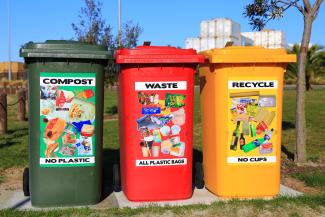NRDC and the Environmental Law Institute (ELI) recently released a Model Ordinance Establishing a Pay-As-You-Throw (PAYT) Program for Residential Municipal Solid Waste that can help municipalities reduce the amount of municipal solid waste (MSW) sent to landfills and incinerators and, at the same time, institute more transparent, efficient, and fair pricing for residential waste management.

PAYT programs establish a system in which households are charged based on the amount of trash they dispose of—and are charged at a higher rate for trash than for recyclables and compostables. Rather than paying a flat fee for unlimited trash disposal, households are incentivized to generate less waste and recycle more, similar to the way in which they pay for other utilities such as water and electricity.
PAYT has already been adopted in thousands of jurisdictions of various sizes, and community surveys indicate that the vast majority of households prefer PAYT to other systems. But many more local governments are missing an opportunity to realize the myriad environmental, social, and economic benefits of PAYT programs.
For many municipalities, PAYT programs can ease the challenge of managing a formidable amount of waste. According to EPA data, over 146 million tons of MSW were landfilled in 2018, the majority of which consisted of materials that could have been recycled or composted. The most prevalent material sent to landfill is food. Nearly 40% (91 million tons) of the U.S. food supply was wasted in 2021, representing the equivalent of 149 billion meals—much of which is landfilled or incinerated.
PAYT has been shown to significantly reduce trash disposal and increase both materials recycling (for items such as paper, plastic, and metal) and organics recycling (for items such as food and yard waste) at the household level. And, by diverting MSW from landfills and incinerators, PAYT programs can lower municipal waste management costs such as tipping and hauling fees.
By helping reduce the amount of disposed waste, PAYT programs can also reduce the harmful public health and environmental impacts of landfills and incinerators, as well as the need to expand and create costly new landfills that are disproportionately sited in low-income communities and communities of color.
In addition, PAYT programs can advance climate change mitigation goals, particularly by decreasing greenhouse gas (GHG) emissions from landfilled and incinerated MSW. In fact, existing research highlights PAYT as one of the most inexpensive, cost-effective strategies for a municipality to decrease its GHG emissions, even more so than many energy efficiency programs.
At the same time, designing, adopting, and implementing a PAYT program can be a daunting and resource-intensive task. The Model Ordinance Establishing a PAYT Program for Residential Municipal Solid Waste is designed to reduce the transaction costs associated with establishing a local PAYT program by providing specific legal language as well as background information and alternative provisions so that municipalities can tailor the model ordinance to their local circumstances.
The Model Ordinance provides clean, “off-the-shelf” legal language that is based on extensive best practices research from around the country. It outlines the fundamental PAYT program components and, given the variety of waste management arrangements around the country, it includes language to adopt PAYT whether the municipal government hauls waste itself or licenses or contracts with private waste haulers. The Model also sets out requirements for robust municipal recycling (including organics recycling) programs so that households have an alternative to trash disposal.
Additional provisions address topics including multifamily units, community engagement, equity and prevention of undue hardship, customer notice, and billing, as well as compliance for both households and private haulers.
A clean version of the Model Ordinance is provided, as well as a version with commentaries including footnotes that explain the benefits of provisions as written and providing examples and alternative approaches. For example, a municipality that doesn’t yet have the capacity to offer curbside collection of compostables could use drop-off sites or other collection methods for organics, or could adopt interim measures such as a pilot curbside collection program to make progress toward a more comprehensive organics recycling program. The Model Ordinance is also accompanied by a compilation of PAYT resources, which curates some of the many existing reports, toolkits, and other documents on the topic that municipalities may find useful in the design and implementation of their PAYT programs.
The Model Ordinance Establishing a PAYT Program for Residential Municipal Solid Waste is part of an ongoing effort to provide municipalities and advocates with tools to reduce the time and resources associated with taking food waste reduction actions. Other models published so far include:
- Model Executive Order on Municipal Leadership on Food Waste Reduction;
- Model Ordinance on Mandatory Reporting for Large Food Waste Generators; and
- Model Compost Procurement Policy.
Additional policy resources and information can be found at the sites for ELI’s Center for State, Tribal and Local Environmental Programs, the ELI Food Waste Initiative, and NRDC's Food Matters program.
This blog originally appeared on November 16 at the NRDC site: https://www.nrdc.org/bio/darby-hoover/model-payt-ordinance-helps-cities-reduce-trash-and-increase-recycling.


